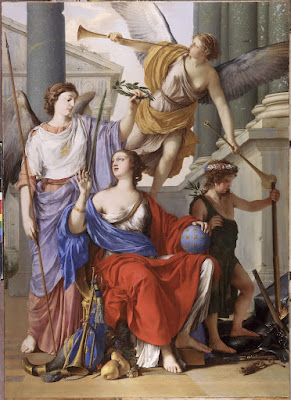-c1820-30-drawing-Mus%C3%A9e-des-Beaux-Arts-de-Valenciennes.jpg) |
| Félix Auvray Allegorical Scene (Child with the Three Fates) ca. 1820-30 drawing Musée des Beaux-Arts de Valenciennes |
-Allegorical-Figures-c1590-95-oil-on-canvas-National-Gallery-Athens.jpg) |
| Carlo Caliari Allegorical Figures ca. 1590-95 oil on canvas National Gallery, Athens |
-Study-for-Allegorical-Composition-c1652-drawing-Hamburger-Kunsthalle.jpg) |
| Giovanni Benedetto Castiglione (il Grechetto) Study for Allegorical Composition ca. 1652 drawing Hamburger Kunsthalle |
-1522-Solnhofen-limestone-relief-Bode-Museum-Berlin.jpg) |
| Hans Daucher Allegory of Dürer's Virtues (armored artist in combat before his patron, Emperor Maximilian I) 1522 Solnhofen limestone relief Bode Museum, Berlin |
 |
| Abraham Hondius Cosmic Allegory ca. 1660-65 oil on canvas Kunstmuseum, Basel |
 |
| Anonymous Italian Artist Holy Trinity in the Tree of Eden flanked by Allegorical Figures ca. 1650 drawing Staatsgalerie, Stuttgart |
 |
| Laurent de La Hyre Allegory of the Regency of Anne of Austria 1648 oil on canvas Château de Versailles |
-Bode-Museum-Berlin.jpg) |
| Anonymous German Artist Allegorical Figure of Discretion 1702-1704 sandstone relief (architectural ornament) Bode Museum, Berlin |
-Bode-Museum-Berlin.jpg) |
| Andreas Schlüter Allegorical Figure of Fortitude ca. 1704 sandstone relief (lunette) Bode Museum, Berlin |
 |
| Michiel Sweerts Allegory of the Sense of Hearing ca. 1655-60 oil on canvas Staatsgalerie, Stuttgart |
-1887-drawing-Hamburger-Kunsthalle.jpg) |
| Adolph Menzel Study for Hammonia (Personification of Hamburg) 1887 drawing Hamburger Kunsthalle |
 |
| Charles Mellin- Allegorical Figure ca. 1630 drawing Statens Museum for Kunst, Copenhagen |
 |
| Balthasar Permoser Flora as Allegory of Spring 1695 ivory Herzog Anton Ulrich Museum, Braunschweig |
-Allegorical-Figure-c1535-36-drawing-(study-for-fresco)-Hamburger-Kunsthalle.jpg) |
| Pontormo (Jacopo Carrucci) Allegorical Figure ca. 1535-36 drawing (study for fresco) Hamburger Kunsthalle |
-Allegorical-Scene-c1585-drawing-Statens-Museum-for-Kunst-Copenhagen.jpg) |
| Antonio Vassilacchi (Antonio Aliense) Allegorical Scene ca. 1585 drawing Statens Museum for Kunst, Copenhagen |
 |
| Jacopo Tintoretto Allegorical Portrait of Ottavio Strada 1567 oil on canvas Rijksmuseum, Amsterdam |
Duke of Guise [soliloquy]:
Now Guise, begins those deepe ingendred thoughts
To burst abroad, those never dying flames,
Which cannot be extinguisht but by bloud.
Which cannot be extinguisht but by bloud.
Oft have I leveld, and at last have learnd,
That perill is the cheefest way to happines,
And resolution honors fairest aime.
What glory is there in a common good,
That hanges for every peasant to atchive?
That like I best that flyes beyond my reach.
And resolution honors fairest aime.
What glory is there in a common good,
That hanges for every peasant to atchive?
That like I best that flyes beyond my reach.
Set me to scale the high Peramides,
And thereon set the Diadem of Fraunce,
Ile either rend it with my nayles to naught,
Or mount the top with my aspiring winges,
Although my downfall be the deepest hell.
For this, I wake, when others think I sleepe,
For this, I waite, that scornes attendance else:
Ile either rend it with my nayles to naught,
Or mount the top with my aspiring winges,
Although my downfall be the deepest hell.
For this, I wake, when others think I sleepe,
For this, I waite, that scornes attendance else:
For this, my quenchles thirst whereon I builde,
Hath often pleaded kindred to the King,
Hath often pleaded kindred to the King,
For this, this head, this heart, this hand and sworde,
Contrives, imagines and fully executes
Matters of importe, aimed at by many,
Yet understoode by none.
Matters of importe, aimed at by many,
Yet understoode by none.
For this, hath heaven engendred me of earth,
For this, this earth sustaines my bodies waight,
And with this wait I'le counterpoise a Crowne,
For this, this earth sustaines my bodies waight,
And with this wait I'le counterpoise a Crowne,
Or with seditions weary all the worlde . . .
– Christopher Marlowe, The Massacre at Paris, scene ii (1593)